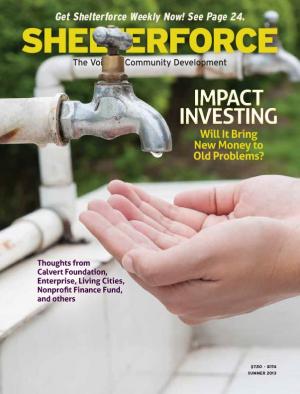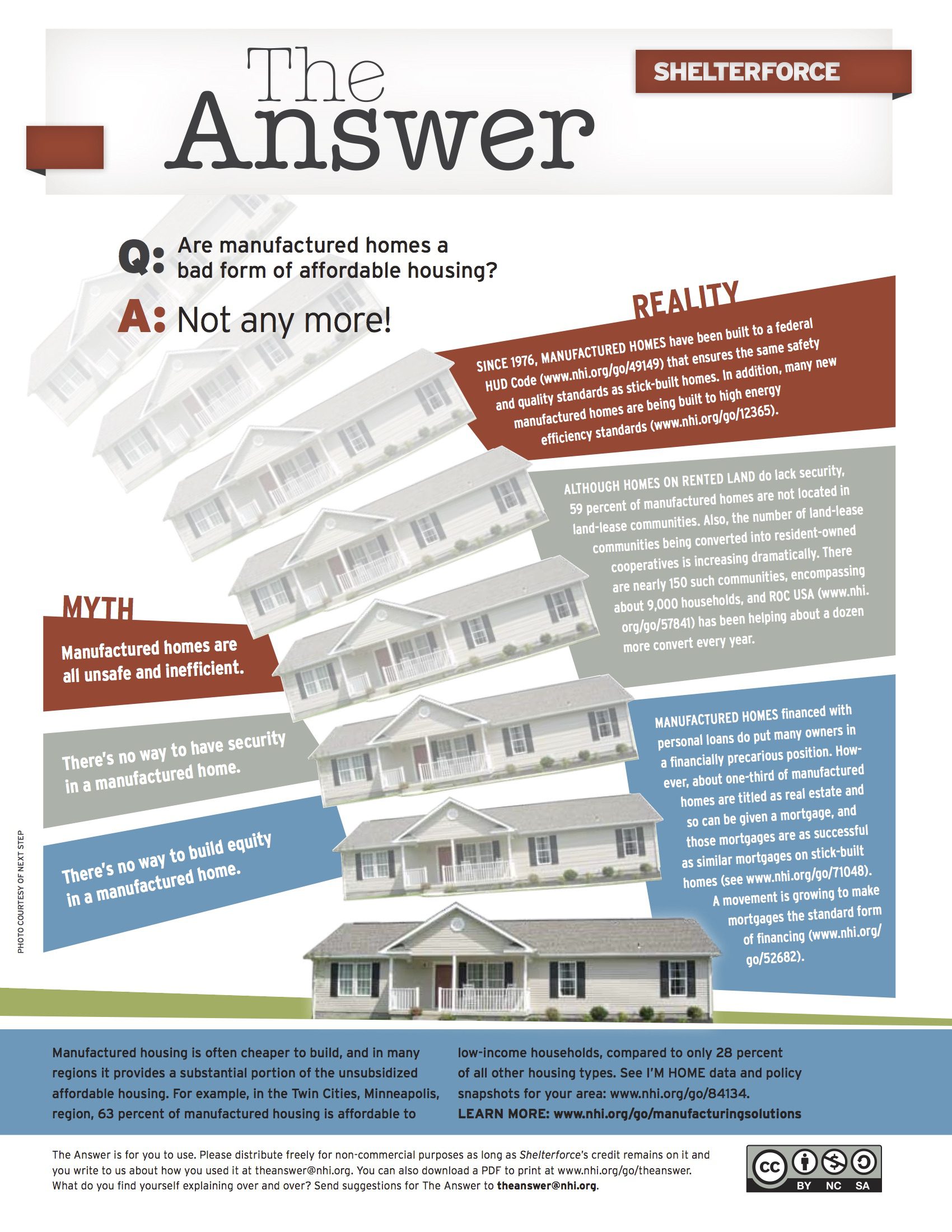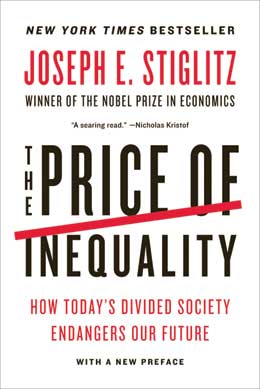
“We believe capital markets have a very important role to play in addressing some of the biggest challenges out there,” Audrey Choi, director of the Morgan Stanley Institute for Sustainable Investing, said in a recent interview. We hope she’s right. Certainly there is a great and growing interest in this kind of investment. In the past few years, with support from Rockefeller, Surdna, Ford, F.B. Heron, other foundations, and many large corporations, there has been an outpouring of research and writing on impact investing. Organizations like NeighborWorks America, Enterprise Community Partners, and Living Cities have been exploring such challenges as preparedness for capital absorption, removing procedural barriers, philanthropic equity, and measuring “blended” financial/social return.
This issue has been designed to introduce you — policymaker, advocate, or practitioner working to improve distressed communities and empower low-income families — to the field of impact investing and to help you understand how such investment might work, how it might affect your work, and what you should do to take advantage of these new sources of capital.
Going beyond our readership, it is also designed to introduce the potential for impact investing domestically in the community development world to a broader audience of potential investors, showing them what community development is and how it would benefit from their investments.
A Cautionary Note
We’ll stipulate up front that more money to deal with pressing social needs in this country or abroad is a good thing. In 2011, JPMorgan and the Rockefeller Foundation estimated that in 10 years this space could be worth $400 billion to $1 trillion. According to the GIIN, over $4.4 billion was invested in 2011. These include investments made worldwide in environmentally sustainable business as well as poverty reduction. The current total size of funds and other sources of capital that devote all or part of their investment strategy to impact investment is estimated between $15 and $28 billion, globally.
We’re excited about all this, but cautious. Today’s numbers sound like a lot, until you remember that the U.S. mortgage interest deduction alone amounts to $70 billion every year. So far, impact investments depend on the desire of investors to get a positive social return, investors who are in many cases willing to take a smaller financial return. Can that willingness really be scaled? And if such investments yield larger returns do we risk exploiting the very people we hope to serve? Will it undermine the role and responsibility of government to address social ills? And will it lead to mission creep as nonprofits try to get a piece of a growing pie?
The title of this note comes from the recent Apostolic Exhortation of Pope Francis, who reminds Christians and all the rest of us about our moral obligation to eradicate poverty. He has some ideas about both the causes of poverty — “the socioeconomic system [that] is unjust at its root” — and its solutions.
“As long as the problems of the poor are not radically resolved by rejecting the absolute autonomy of markets and financial speculation and by attacking the structural causes of inequality, no solution will be found for the world’s problems or, for that matter, to any problems. Inequality is the root of social ills,” Pope Francis writes.
Impact investment, however much it mitigates the effects of short-term profit-maximization and humanizes capital, will not solve inequality on its own. But at a time when even Republicans Paul Ryan and Marco Rubio, no matter their motivations or sincerity, have been speaking out about poverty and affirming government’s role in reducing it, maybe what we can hope for is that impact investing, along with a moral sea change, relentless organizing and advocacy for social and political change, and the important work all our readers do, can reinvigorate the 50-year-old War on Poverty. And maybe we can win that war this time.
Thank you!
Lisa Davis and Christine Looney are program officers at the Ford Foundation. They helped us organize our advisory meeting, assuring that the right people were invited and that our meeting agenda hit the right issues. They graciously provided meeting space at the foundation and logistics support.
Jed Emerson is a thought leader in impact investing and founder of the Blended Value Group. He introduced us to the concept almost two decades before it even had a name when he first wrote for Shelterforce. He pioneered the idea of “blended value” that underpins all of impact investing. He, along with Antony Bugg-Levine, now at the Nonprofit Finance Board, co-authored “Impact Investing,” published in 2011. Jed continues to write about the field and consult with individual investors, fund managers, and nonprofit entrepreneurs worldwide.
David Erickson is the manager of the Federal Reserve Bank of San Francisco’s Center for Community Development Investments and the editor of its journal Community Development Investment Review (CDIR). CDIR is one of the best publications on community development economics and investments available; always clear, thorough and engaging. Even beyond the journal, David and his team work to lift up the best ideas and emerging practices in the field. Like Shelterforce, they search for what works, what doesn’t and why. And they do a great job of it.
Following are the people who participated in the advisory meeting and/or provided valuable advice before or after the meeting.
Ana Marie Argilagos
U.S. Department of Housing and Urban Development
Margot Brandenburg
Rockefeller Foundation
Antony Bugg-Levine
Nonprofit Finance Fund
Audrey Choi
Morgan Stanley
Rodney Christopher
F. B. Heron Foundation
Amy Chung
Living Cities
Frances Ferguson
NeighborWorks America
Catherine Godschalk
Calvert Foundation
Robin Hacke
Living Cities
Lisa Hall
Calvert Foundation
Carrie Hutchinson
Calvert Foundation
Kevin Jones
SoCAP
Justina Lai
Rockefeller Foundation
Giselle Leung
Global Impact Investing Network
Bryna Lipper
U.S. Department of Housing and Urban Development
George McCarthy
Ford Foundation
Kelly Melia-Teevan
Rockefeller Foundation
Dana Pancrazi
F.B. Heron Foundation
Preston D. Pinkett III
City National Bank
Mark Pinsky
Opportunity Finance Network
Debra Schwartz
MacArthur Foundation
Liz Sessler
Enterprise Community Partners
Abby Jo Sigal
Enterprise Community Partners
Ben Thornley
Pacific Community Ventures
Barbara VanScoy
Community Capital Management
Meg Voorhes
US SIF: The Forum for Sustainable and Responsible Investment
Lisa Woll
US SIF: The Forum for Sustainable and Responsible Investment
David Wood
Initiative for Responsible Investment, John F. Kennedy School of Government
If we missed anyone, please understand it is a function of waning memory not waning gratitude and let us know.
We also compiled a resource guide to some additional impact investing-related organizations and reports that deserve your attention.





Comments